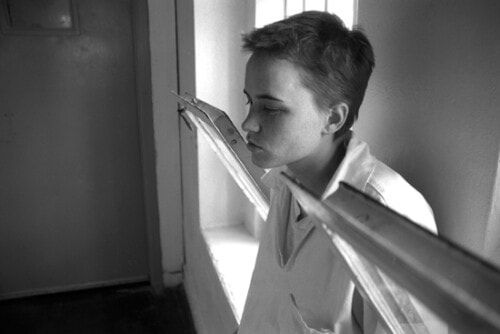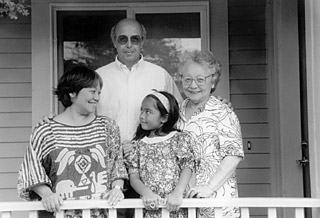Kosovo Theater Project
In the theater, there is also an improvisational quality of the interaction. The theater exploration, which attempts to transform the traumatic impressions into shared artistry, complements the archival research, which aims to transform the traumatic impressions into shared history.
February 23, 2000. Third day. Robert decided he would begin our contribution by leading the two theater workshops in the “puppet” exercise. A square cloth is tied with five knots; one at each corner, a fifth tied in the center. The cloth lays on the ground, lifeless. Five students surround the cloth. Each is to take hold of a knot; one for each leg, one for each arm and the center knot becomes the head. Robert, explains, “The puppet does not yet exist. You bring it to life. You each take a knot into one hand and work together to wake it up to life. The puppet wakes up, it takes a nice walk, and lies down again.” In the morning session, the “younger” group tried the exercise. The first five students leaned down, surrounding the puppet. They each gingerly and tentatively took a knot in one hand. The puppet jerked up and jumped about, but was not very coordinated. A second team tried it; Robert, ever the teacher, knew to remain silent, allowing the second group to learn from the first. The puppet arose with greater coordination, and was soon leaping about. The third and forth group taught the puppet to dance, before the puppet dropped to the ground lifeless again.

In the afternoon, it was the “older” group’s turn. Again the first five were clumsy. The second five were better, raising up the puppet more slowly, a bit more lifelike this time, but instead of walking, it glided across the floor like a ghost. Robert spoke to them, as the third group of five took up its position, “Very lovely. But you must take your time. And remember to welcome the emotion. Always welcome the emotion. The puppet is born, gets up, takes a walk, and lies down again. When it returns to the ground, the exercise is over.” The translator translated Robert’s French-accented English into Italian for the Altrimenti group and into Albanian for the counselors. As the third group gets ready to begin, Robert invites the other students, not directly involved in the exercise, to make sounds and add light to the scene with a flashlight. Slowly, with exceptional coordination the puppet begins to move. It sits up and rubs its eyes. The sound of an infant crying is heard. The puppet tries tentatively to stand; the sound of tears turns to curiosity, a bit of laughter. It’s up! Then a few fitful, toddler-like steps. The steps turn into a walk, slowly across the room. The sounds of animals are heard, the puppet stops and listens. Then it continues, as if growing older with each step. A drumbeat accompanies the puppet as it walks through its life. Suddenly, the dream beats out a harsh series of taps. Gunfire. The puppet shakes. It stops, and then it sits, wounded and simultaneously tired. More gun fire. The puppet is hit again, and slowly descends to the ground completely. It is dying. A mournful song arises from somewhere. The puppet lies still. The exercise is at an end. But no, it continues. A student lifts the arms of the puppet and crosses them. Another brushes off the body, another straightens the legs, a fourth strokes its face. The light shifts from the puppet to the students, from face to face. One student leans over and kisses the puppet; another whispers a prayer. The mournful song becomes a funeral dirge; the faces of the students are streaked with tears.
This workshop took place less than a year after the end of the war in Kosovo. Conditions were harsh. Aside from the water and electricity outages, the soldiers, the tanks and patrolling helicopters, there were violent outbreaks, protest marches, fear among the girls of abductions. Nonetheless, the workshop of 40, divided into two groups, dedicated themselves completely to learning these theater techniques, with their emphasis on the non-verbal communication of meaningful experience. With great enthusiasm, they learned to become more trusting of one another; improved their communication skills; developed a sense of their own creative abilities; came to feel more confident that people who don’t know each other can have something valuable to offer one another; came to understand, through experience, that people from different backgrounds can share values and deeply emotional experiences in a mutually beneficial way. They also learned the value of creative expression as a way of responding to and transforming traumatic experiences in a manner that neither forgets the past nor maintains the trauma. And, most important for me was the verification of my belief that in the immediate aftermath of suffering, the soul cries for attention and expression as much as the body, and that offering artistic expression to the survivors is as important as offering any other kind of medicine to the wounded.
Interestingly, the two groups of counselors demonstrated different group “characters” and created different styles of improvisation, along with differing themes. It happened that one group of 20 consisted predominantly of the younger students, whereas the other group was, on average, substantially older. The younger group was more playful, interested in moving onward, and in ending things happily; they tended to structure their improvisations with the conflict coming early and ending in a resolution, which could include nationalism, marriage, birth, and a return to a fantasized normalization. Bad experiences were quickly turned to action; in other words, the younger group tended to prefer scenarios of trauma avoidance to scenarios of trauma transformation. When a group of young male counselors was complimented on a piece of work, one shouted, “We are more than good! We are perfect! We are Albanian!”
The older group was more able to tolerate the complex feelings brought on by the war; they addressed their mourning processes symbolically. They were less likely to turn the work towards nationalism, towards happy endings, toward answers. In the puppet exercise of the younger group, the puppet tended to dance, and the group followed Robert’s instruction that when the puppet lay down again the exercise was over. For the older group, only when the puppet lay down at the end did the puppet scenario begin in earnest.
February 23, 2000. It is midnight, and Robert and I are each writing our impressions. A bright spotlight from a noisy military helicopter sweeps past our window and over the entire area, reminding us that the streets are still not safe at night. I am covered by three blankets and a sleeping bag. The thermometer on my clock reads 6°.
Earlier this evening, at a meeting of the Altrimenti group, I was presented with a problem. The group did not know how to end this first part of the theater intervention with the students. They had decided on a closing ceremony for all participants: an installation and party which is to be a work of art, a feast, a sharing celebration of what has been accomplished so far and a promise of what is to continue. But what to ask of the students for the final class? I told them that my teacher in the theater, Joseph Chaikin, taught me that the ending of a piece of theater is the most important part of the work because it determines how everything that came before it is to be remembered. I suggested that we meet tomorrow with the entire group of 40 students and ask them, as a final exercise, to present us, their guests, with a parting gift: an improvised performance which makes use of what they have learned so far.
The final workshop session of the February session brought together both groups of counselors, translators, theater artists and guests. The students were presented with the final task, to give us, as a farewell gift, an improvised performance, which makes use of what they have learned so far. They were given an hour to prepare.
The younger group went right to work, arguing and planning, searching for props and laughing. The older group dispersed; they did not speak to one another very much, other than to share a cigarette or gather around the heaters. A few of the women disappeared into the bathrooms. I was perplexed at the apparent lack of response among the older group. The younger group presented their improvisation first. They had recreated Robert’s puppet. Five of the students brought it to life with an energy and focus that they hadn’t been able to give it before. The puppet stood and walked toward those of us watching. It approached each one of the teachers and offered a silent, specific and emotionally rich farewell. The puppet could bow, entreat, and cry on behalf of the students. They found a perfect gift for us, a farewell completely inscribed in the non-verbal realm of the theater, which expressed complex emotions in the simple poetic movements of a piece of white cloth.
Then, the older group began its performance. Certain actors arranged themselves onstage in full costume, with instruments and props, drawing on Kosovar folk traditions. It became evident at once that the older group hadn’t needed the time to develop an idea because they had organized and rehearsed a farewell performance for the teachers on their own, in secret. It consisted of the enactment of the story sung in a traditional folksong: a bride is preparing for her wedding with her family and friends. Meanwhile, unbeknownst to them, the groom has been kicked in the head by a horse. He is lying dead, while the family awaits the moment of the wedding. Slowly, one, then another and eventually all, up to the bride herself, discover that the bridegroom is dead. The bride is a widow before ever experiencing the joys of married life. The performance had no dialogue, only the mournful singing of the folksong by the women onstage. The audience watched and cried. Tears flowed unabashedly as the story of unexpected tragedy unfolded.



